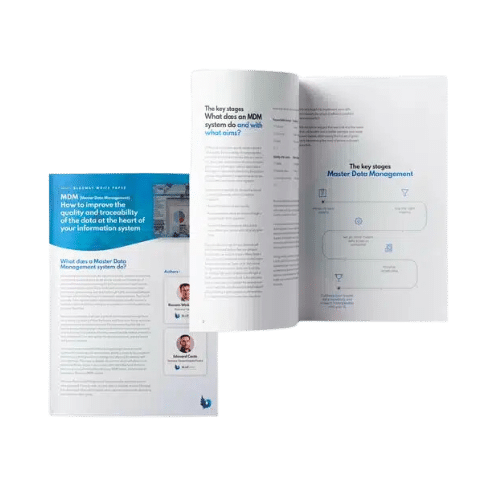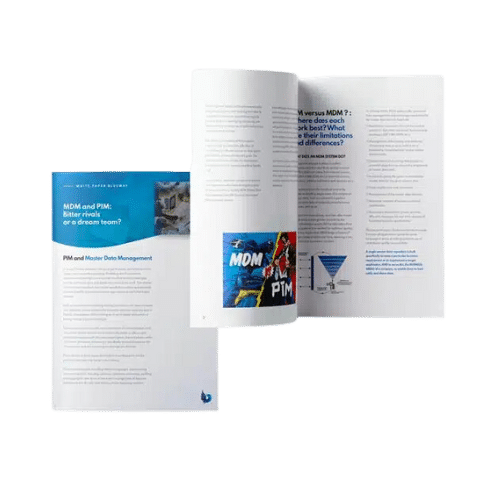Businesses are by now fully aware of the control issues surrounding master data and data quality. However, initiating a transformation and implementing MDM projects always and still gives rise to questions about methods, and requires a degree of competence in best practice.
In this interview, Isabelle François shares with us her experience of two master data management solution implementation projects.
Could you tell us the background to the two MDM projects you were involved in?
Isabelle François : The first experience took place in a leading plastic packaging company. The project background was a familiar one: the business was planning to change its ERP system in the next year, and wanted to plan ahead for such a major project. It therefore wished to centralise and quality check all its data, to be ready for the switchover to the new ERP system.
Another issue was cleansing the data, and the need for a robust solution able to distribute data to source applications. Priority was given to product item and supplier objects. Data was previously not particularly centralised, in fact, with queries technically routed to each source application. Head office found it impossible to have a consolidated, aggregate picture of their data. The usual problems were found, such as duplicate data. For instance, every application created its own supplier record. The impact that can have within a large international group can easily be imagined…
The second project was run in an international healthcare group, facing similar issues. Third parties could have a number of facets, e.g. customers, suppliers, etc. and head office wanted an overview of the connections between third parties. The issue was one of strategy: did they need to set up a central procurement unit? How could they obtain a full, consolidated picture of data traffic between all entities? With compartmentalised applications following their own logic and focused on their own business lines, harmonisation was a highly complex affair.

Master Data Management : data quality and traceability at the heart of your information system
Was implementation and organisation of the two master data management projects similar?
I.C : No! Having the same target does not mean that implementation follows the same path. These two projects are a good example of that. You have to adapt to the maturity of the business and their internal resources.
Both of these MDM projects started with the “supplier” entity. It is often preferable to set up automation and best practice on a relatively simple object, and then to broaden the scope to more complex areas, such as “products”.
In the case of the pharmaceutical company, in-house teams managed the data acquisition in our MDM software. At the same time, the establishment of processes for entering new suppliers, and amending and extending existing supplier data, were key issues. We took charge of this aspect, through our BPM (Business Process Management) module, Processs Governance.
Using the BPM module, the “golden record”, or master data record, was built. These processes consequently ensure the uniqueness of supplier data by allowing relevant parties to enter and enrich it through a suite of interfaces. Each role adds and ratifies data. The BPM module can then distribute the data to other applications, in particular to SAP.
In the project for the plastic packaging manufacturer, we coached the customer’s team and guided them throughout the project. The first step we managed was the data take-on, from about thirty different sources. This MDM project presented a weighty challenge in standardising the data take-on, and developing a central service to structure data and add it into the MDM system.
If data take-on was to be successfully standardised, using different services for different source applications had to be avoided at all costs. This would have posed a real threat to ensuring the quality and uniqueness of the data.
Isabelle François
Data was consequently automatically loaded into Blueway’s MDM system, retrieved from a wide variety of sources with varying formats, analysed and sent back to the sources after being quality controlled. In the space of three months, we successfully integrated all the supplier data from more than 30 sources, a real challenge. In the first month, we quickly identified data entry and format errors and duplicates within the source applications. The customer’s business-line staff completely understood the philosophy behind MDM and responded promptly when making corrections.
With this standardised process, sources could continue to populate the MDM module automatically, pending the integration of the new ERP system.

MDM versus PIM: bitter rivals or a dream team ?
Were there any specific constraints on deploying these data management solutions?
I.C : In the pharmaceutical company, the constraints mainly revolved around the very precise functional rules required within the BPM system. For example, data input rules varied according to the type of supplier, system permissions management had to handle a very finely-tuned routing of tasks and data based on the company and the user, and so on.
The objective was to keep control over any supplier creation or modification, regardless of the company in the group. The aim was to stop creating suppliers in every application, to centralise everything in Blueway’s BPM, and then distribute data to the source applications that needed it.
The international dimension of both projects also meant that fully multilingual applications were required.This is a frequent issue, but one that has particular impacts where data management solutions are concerned.
As always, delimiting the rules at an early stage, and avoiding any changes during the project, definitely helps prevent schedule slippage. Otherwise, changing the rules mid-project means re-running entire batteries of tests!
When Marketing joined the project for the catalogue aspect, once the supplier entity had been dealt with, we also realised the importance of adapting the approach to suit different users.For example, Marketing attached far greater importance to screen design than the ERP users. We tweaked the interface accordingly to meet their requirements and improve their buy-in to the solution.
Are there any points you would like to highlight about these data management projects?
I.C : One key success factor is having staff on the customer side who are available, committed and have a clearly-defined role. For example, in one of the projects, the customer team consisted of the project sponsor to ratify the general direction taken, a technical contact and a contractor who worked on the data modelling. A fine trio!
Standardisation of the data acquisition was a very interesting process, which certainly sped up project progress and made the results more reliable. It was also an opportunity to confirm that Blueway was well-suited to massive data migration exercises.
So these projects also helped enhance our product. Listening to customers to meet their needs precisely, and including good ideas in upcoming versions of our solutions, are an integral part of our DNA. We are a small business and we can be agile.
In closing, both projects are good examples of Blueway’s strengths. The packaging manufacturer selected us because we could standardise the data take-on process without bespoke development, and have a robust solution available pending the ERP implementation. For our pharmaceutical customer, the link between BPM and MDM was the decisive factor.
In both cases, issues that might appear to be separate, such as MDM, BPM, ESB, etc. do in fact tend to dovetail together as regards running a successful data-centric project. This belief underpins the philosophy behind the Blueway platform!

Want to discuss your data management challenges with an expert?





